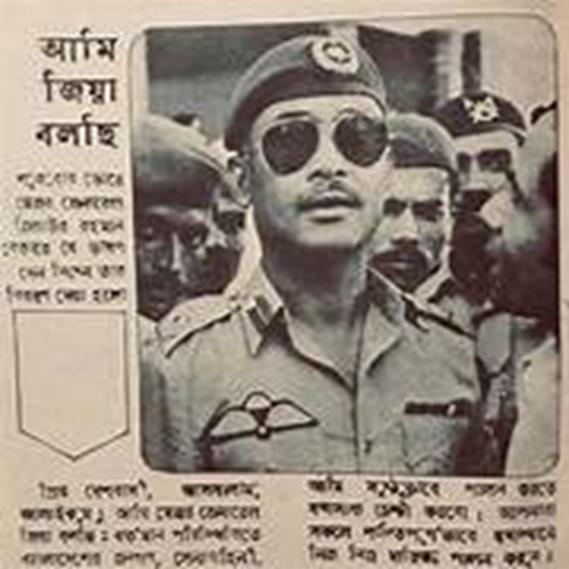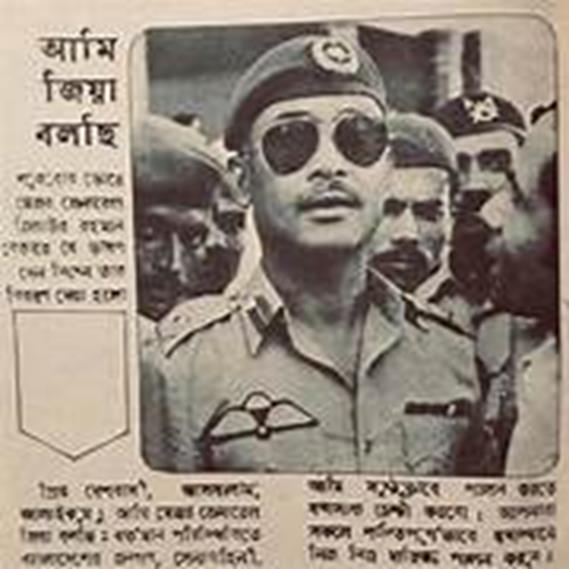
General Ziaur Rahman among the soldiers who rescued him from custody and reinstated him in authority on November 7, 1975.
November 7 is Inseparable from November 3 and August 15 Events
Those who lived in Bangladesh during the latter part of 1975, will recall the historic events they have seen and experienced. A nation was reborn on August 15 and again on November 7, 1975, only to be disturbed a little in between by a vicious coterie. Let us revisit the time.
August 15, 1975
A military coup, spearheaded by a group of young officers, ousted the autocratic BAKSAL government of Sheikh Mujibur Rahman. (BAKSAL, Bangladesh Krishak Sramik Awami League, a socialist inspired one-party governing system). Unfortunately, Mujib and most of his family members died in the predawn military action.
For Bangladesh, it was a Day of Deliverance, as designated by Ataur Rahman Khan, former veteran Awami League leader. It saved the country from a destructive slide–political, economic, social and of national values and aspirations. For the people, they were saved from a “Zalem Feraun”, as described by then (Awami League) Speaker Abdul Malek Ukil. 30,000 patriots were killed, 62,000 political opponents were sent to jail to rot and 1.5 million people were made to die directly and indirectly in a man-made famine under Mujib’s unprecedented corruptive administration. National interests were leased out to Indian hegemony.
There were no tears, no regret at the fall of Mujib. People rejoiced instead everywhere. After the death of Sheikh Mujib, “streets were filled with processions. The truth was, those were of happiness,” wrote popular novelist Humayun Ahmed in his book Deyal. “A Public Relief, –A Historic Beginning,” were the editorials of the popular Ittefaq, an Awami oriented daily, on August 16, 1975. Chiefs of defense forces, Police, Rifles, Rakkhi Bahini and Ansar publicly declared total their support and allegiance to the new government.
Mujib’s own Awami League was largely happy too. Within hours, it formed the next government, keeping most of the former cabinet members. In an emergency Parliament Session held within days at the Bangabhaban, the presidential residence, almost all the Awami League members attended. They were unanimous in supporting the military coup, leadership change and showering praise on the new leader Khandakar Mushtaq Ahmed, a.close Mujib associate.
November 3, 1975
However, the August Revolution didn’t go well with a group of haughty and ambitious army officers. Led by Brigadier Khaled Mosharraf, army’s Chief of the General Staff, they could not accept the fact that a few junior officers accomplished the spectacular feat on August 15 thereby dwarfing them. Missing the boat, they conspired and tried to undo and outdo the August 15. Indian intelligence was said to be behind the move to reestablish their hegemony in Bangladesh.
In the early hours of November 3, 1975, Khaled, with the help of a few of his loyal elements, staged a military move to usurp the power. He arrested army chief General Ziaur Rahman, promoted himself to a general and took over as the new army chief. He also declared Martial Law, with him as the Chief Martial Law Administrator, dissolved the cabinet and suspended the constitution. August 15 leaders were sent on exile. Outside Dhaka, few knew what had happened, and public life, including that in the capital, was normal. The only snag was the ominous silence of the electronic media.
An unfortunate incident happened in which four top leaders of the Awami League–Syed Nazrul Islam, Tajuddin Ahmad, Mansur Ali and Qamaruzzaman–were killed inside the Dhaka jail in the morning of November 3. It has not been clearly established who committed the criminal act. An Awami partisan trial implicated the August 15 officers, most of whom were not even aware of the incident until much later, and at least one of them was not in Dhaka that time.
Khaled’s command and control was limited and short-lived. Majority in the military and the nation was against his conspiratorial putsch to negate the historic and widely hailed August 15. Arrest of Ziaur Rahman did not go well either. A top freedom fighter and an efficient officer, Zia was very popular in the military. By declaring the Independence of Bangladesh in March 1971, he became a household name.
November 7, 1975
In the wee hours of the morning on November 7, 1975, soldiers of the Dhaka Cantonment came out en masse against Khaled and his anti-national, anti-people conspiracy. Retired Colonel Abu Taher, a wounded freedom fighter and fiercely left oriented officer, had a role in initiating the troops’ revolt but the revolution soon followed its own dynamics. The public, disgusted at the November 3 intrigue, instantly joined the soldiers in the uprising, which came to be known as Sipahi-Janata Biplop (Soldiers-People Revolution). It was later officially designated as the National Revolution and Solidarity Day.
Troops of 2 Field Regiment Artillery, under Major Mohiuddin and Subedar Major Anis, stormed Zia’s residence and rescued the general. They brought him to their unit and reinstated him to authority. 2 Field Artillery was Ziaur Rahman’s operational headquarters for the next few days. (This unit, founded and commanded by Captain Rashed Chowdhury in 1971, was part of Ziaur Rahman’s Z Force in the liberation war).
It was Ziaur Rahman’s second coming in rescuing the nation from a serious crisis, the first being in March 1971. After the Pakistan military commenced genocide of the unarmed and innocent Bengalis on the night of March 25, 1971, most political leaders, including Sheikh Mujibur Rahman fled the scene for safety. In that critical moment and leadership vacuum, then Major Ziaur Rahman rose to the occasion and declared the independence of Bangladesh on March 27, and started a protracted war of liberation from Chittagong. All freedom loving people of the country–soldiers, police, Ansars, students, teachers and common people–joined the war of independence and won victory on December 16, 1971.
Upon failure of the conspiracy, the counter-coup plotters fled. While on the run, Khaled and two of his aides were caught at Dhaka’s Sher-e-Bangla Nagar and later killed by the angry soldiers of his own loyal unit (10 Bengal Regiment).
(For further details on the November 7 events, please visit Bangladesh: National Revolution and Solidarity Day, its Significance and its Precursor (With inside stories) at: http://southasiajournal.net/bangladesh-national-revolution-and-solidarity-day-its-significance-and-its-precursor-with-inside-stories/
Also, “November 7 Revolution Catapults Zia to Glory”, pp 181-188, A Soldier and The War Within: Post-Independence Bangladesh, Rashed Chowdhury, Amazon, 2022).
Public Reaction on November 7
Below are a few media snippets on the public reaction on November 7, 1975. Most of the narratives are translated from original Bangla by the writer.
The Daily Ittefaq: November 9, 1975: “An unprecedented and historic victory heralded in the life of the Bengali nation last Friday (November 7). On this victory, the people wrote the names of victorious soldiers with their heartfelt sentiments. The name that shined on top of that list was Major General Ziaur Rahman, Bir Uttam, a dear and competent personality. Friday morning snatched for the nation a sun of bright future, bravery and self-esteem. The exuberance of the Sipahi-Janata, their joint victory processions of happiness and the common voice of millions expressed solidarity and oneness.”
Anthony Mascarenhas, Bangladesh: A Legacy of Blood, 1986: “Learning that Ziaur Rahman was free from custody, the whole country was rejoicing in happiness. People from all walks of life expressed their happiness by singing and dancing… For three days, people thought that India, through Khaled Mosharraf, had snatched their hard-earned independence.”
Davis Eugene Boster, US Ambassador in Dhaka, as reported by Syed Abul Maksud in Prothom Alo on November 9, 2010: “Whatever we witnessed on the streets on November 7 and if they carried any meaning, it proved beyond doubt that Zia had a huge popularity.”
The Daily Bangla Telegram November 8, 1975: “Everywhere Sipahi and Janata met and embraced each other in happiness. Shoulder to shoulder, hands in hands, one voice, one sound: “Sipahi-Janata Bhai-Bhai; Bangladesh Zindabad, Major General Ziaur Rahman Zindabad; Khandokar Mushtaq Zindabad; We will protect our independence; come put hands in hands–Sipahi-Janata One.”
No Isolated Event
November 7 did not happen in a vacuum. It is a byproduct, in other words, reincarnation of August 15. Those who, particularly today’s BNP, try to think that the Sipahi-Janata Biplop took place by itself, in isolation, are the greatest deniers of reality and history. It is a betrayal to the making and ideals of Ziaur Rahman, one of the greatest sons of the soil, and denial of BNP’s parentage.

